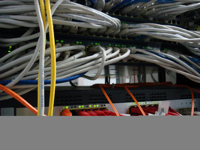Error: The image in the archive which would be used to upgrade
Error: system number 1 does not support the same feature set.
I just got this error message while upgrading a Cisco Catalyst 3560 from 12.2(35)SE5 to 12.2(44)SE. The older version was IP …
 Oops! I guess I'm way behind the times.
Oops! I guess I'm way behind the times. I've talked about using Cisco
I've talked about using Cisco  When setting up a Cisco ASA or PIX to send logs to a remote syslog server, you need to specify which facility to use. This can cause a bit of disconnect since the syslog server configuration uses names and the
When setting up a Cisco ASA or PIX to send logs to a remote syslog server, you need to specify which facility to use. This can cause a bit of disconnect since the syslog server configuration uses names and the  I could blame it on the late hour, but the truth of the matter is that I'm just a bonehead.
I could blame it on the late hour, but the truth of the matter is that I'm just a bonehead. I've noticed a mysterious new protocol popping up in my protocol lists lately: 19101/TCP. Apparently, this TCP port is used by the
I've noticed a mysterious new protocol popping up in my protocol lists lately: 19101/TCP. Apparently, this TCP port is used by the  What is Local
What is Local  Today I was browsing through the
Today I was browsing through the  By default Point-to-Point Tunneling Protocol (PPTP) will now work properly through a Cisco Adaptive Security Appliance (ASA) firewall or it's forerunner the Cisco
By default Point-to-Point Tunneling Protocol (PPTP) will now work properly through a Cisco Adaptive Security Appliance (ASA) firewall or it's forerunner the Cisco  The following are the Peer-to-Peer (P2P) protocols recognized by Cisco's NBAR Protocol Discovery.
The following are the Peer-to-Peer (P2P) protocols recognized by Cisco's NBAR Protocol Discovery. Occasionally you might need an Autonomous System Number (ASN) that is only used on your network. The need for these should be infrequent, but it does happen.
Occasionally you might need an Autonomous System Number (ASN) that is only used on your network. The need for these should be infrequent, but it does happen. You'll find that some network problems can only be solved by sticking a
You'll find that some network problems can only be solved by sticking a 